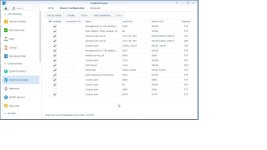So I followed this guide to the T: https://www.wundertech.net/synology-nas-openvpn-server-setup-configuration/
As well as watched the video, and 2 others just like it, several times over.
After all is said and done on step 6, I email the config file to my iPhone, put it into the app, and after loading for about a minute I get ''There was an error attempting to connect to the selected server.''
It works just fine when I'm on my home network, just not on my cell network.
The log the first couple of times said:
''Connecting to (My Synology's static IP adress):1194 (My Synology's static IP adress) via UDPv4''
''Can't assign requested adress''
Okay..
After a phone reboot, the log now says: (See below)
So I tried hotspotting an Android phone to my PC, and putting the config file into the OpenVPN desktop app there, and got the same problem - ''Server poll timeout, trying next remote entry...''
Again, works fine on WiFi, just not on any other network.
I've spent 3 days on this. Anyone got any ideas?
As well as watched the video, and 2 others just like it, several times over.
After all is said and done on step 6, I email the config file to my iPhone, put it into the app, and after loading for about a minute I get ''There was an error attempting to connect to the selected server.''
It works just fine when I'm on my home network, just not on my cell network.
The log the first couple of times said:
''Connecting to (My Synology's static IP adress):1194 (My Synology's static IP adress) via UDPv4''
''Can't assign requested adress''
Okay..
After a phone reboot, the log now says: (See below)
So I tried hotspotting an Android phone to my PC, and putting the config file into the OpenVPN desktop app there, and got the same problem - ''Server poll timeout, trying next remote entry...''
Again, works fine on WiFi, just not on any other network.
I've spent 3 days on this. Anyone got any ideas?
Code:
2022-02-27 20:09:45 1
2022-02-27 20:09:45 ----- OpenVPN Start -----
OpenVPN core 3.git::58b92569 ios arm64 64-bit
2022-02-27 20:09:45 OpenVPN core 3.git::58b92569 ios arm64 64-bit
2022-02-27 20:09:45 Frame=512/2048/512 mssfix-ctrl=1250
2022-02-27 20:09:45 UNUSED OPTIONS
1 [tls-client]
3 [pull]
5 [script-security] [2]
2022-02-27 20:09:45 EVENT: RESOLVE
2022-02-27 20:09:45 Contacting [192.168.1.250]:1194/UDP via UDP
2022-02-27 20:09:45 EVENT: WAIT
2022-02-27 20:09:45 Connecting to [192.168.1.250]:1194 (192.168.1.250) via UDPv4
2022-02-27 20:09:55 Server poll timeout, trying next remote entry...
2022-02-27 20:09:55 EVENT: RECONNECTING
2022-02-27 20:09:55 EVENT: RESOLVE
2022-02-27 20:09:55 Contacting [192.168.1.250]:1194/UDP via UDP
2022-02-27 20:09:55 EVENT: WAIT
2022-02-27 20:09:55 Connecting to [192.168.1.250]:1194 (192.168.1.250) via UDPv4
2022-02-27 20:10:06 Server poll timeout, trying next remote entry...
2022-02-27 20:10:06 EVENT: RECONNECTING
2022-02-27 20:10:06 EVENT: RESOLVE
2022-02-27 20:10:06 Contacting [192.168.1.250]:1194/UDP via UDP
2022-02-27 20:10:06 EVENT: WAIT
2022-02-27 20:10:06 Connecting to [192.168.1.250]:1194 (192.168.1.250) via UDPv4
2022-02-27 20:10:16 Server poll timeout, trying next remote entry...
2022-02-27 20:10:16 EVENT: RECONNECTING
2022-02-27 20:10:16 EVENT: RESOLVE
2022-02-27 20:10:16 Contacting [192.168.1.250]:1194/UDP via UDP
2022-02-27 20:10:16 EVENT: WAIT
2022-02-27 20:10:16 Connecting to [192.168.1.250]:1194 (192.168.1.250) via UDPv4
2022-02-27 20:10:27 Server poll timeout, trying next remote entry...
2022-02-27 20:10:27 EVENT: RECONNECTING
2022-02-27 20:10:27 EVENT: RESOLVE
2022-02-27 20:10:27 Contacting [192.168.1.250]:1194/UDP via UDP
2022-02-27 20:10:27 EVENT: WAIT
2022-02-27 20:10:27 Connecting to [192.168.1.250]:1194 (192.168.1.250) via UDPv4
2022-02-27 20:10:37 Server poll timeout, trying next remote entry...
2022-02-27 20:10:37 EVENT: RECONNECTING
2022-02-27 20:10:37 EVENT: RESOLVE
2022-02-27 20:10:37 Contacting [192.168.1.250]:1194/UDP via UDP
2022-02-27 20:10:37 EVENT: WAIT
2022-02-27 20:10:37 Connecting to [192.168.1.250]:1194 (192.168.1.250) via UDPv4
2022-02-27 20:10:45 EVENT: CONNECTION_TIMEOUT [ERR]
2022-02-27 20:10:45 Raw stats on disconnect:
BYTES_OUT : 812
PACKETS_OUT : 58
CONNECTION_TIMEOUT : 1
N_RECONNECT : 5
2022-02-27 20:10:45 Performance stats on disconnect:
CPU usage (microseconds): 119945
Network bytes per CPU second: 6769
Tunnel bytes per CPU second: 0
2022-02-27 20:10:45 EVENT: DISCONNECTED
2022-02-27 20:10:45 Raw stats on disconnect:
BYTES_OUT : 812
PACKETS_OUT : 58
CONNECTION_TIMEOUT : 1
N_RECONNECT : 5
2022-02-27 20:10:45 Performance stats on disconnect:
CPU usage (microseconds): 139994
Network bytes per CPU second: 5800
Tunnel bytes per CPU second: 0 [/CODE

